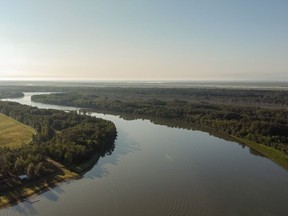The oldest European settlement in Saskatchewan is Cumberland House, founded by the Hudson Bay Company in 1774.

European contact with the First Nations in Saskatchewan took place in the north first and much later in the south. When we think about the province’s history, the north is often left out or ignored completely.
It would be another century before the treaties would be negotiated and European settlement would begin in the south.
The Hudson Bay Company was established in 1670, but for nearly a century it traded out of its fort at York Factory on the coast. The Cree people served as middlemen, purchasing trade items and returning with canoes laden with furs.
The Cree told the company staff that there were fierce tribes inland and it was too dangerous for them to leave the fort. It was a good scam, but eventually the HBC personnel caught on and they decided to explore inland.
Meanwhile, the Cree used their profits from trading to purchase firearms and venture further out on the Plains. Nations that once lived on the Plains were displaced and moved further south. These included the Northern Shoshone, the Gros Ventres and the Blackfoot, who moved further west into what is now southern Alberta.
The Cree allied with the Nakota and Saulteaux and together they formed the “Iron Nation,’ so called because they had access to firearms, which the southern tribes lacked.
The introduction of firearms and increased commerce brought the Dene and Cree nations into conflict. Early in the 19th century the two nations gathered at Peace Point on the Peace River to the west of Fort Chipewyan. They agreed to live in peace and the river would be the dividing line between the two nations. The river was named the Peace River in recognition of the treaty.
In Saskatchewan the watershed of the Mackenzie River includes Lake Athabasca and Black Lake down to Wollaston Lake. The northeast corner, including La Loche, and the upper reaches of the Churchill River are Dene territory.
The two sides kept the treaty and peace has been maintained ever since.
Indigenous people have lived in Saskatchewan since the last ice age. About between 10,000 and 12,000 years ago the glaciers melted, giving way to this new land. Our people moved north and along with the animals adapted and thrived on this gift from the Creator.
Where we came from is a matter of debate, but it appears that people came by boat across the Pacific and others crossed the land bridge linking Turtle Island with Siberia.
When my father was teaching at the University of Winnipeg, he donated some of his DNA to a research project. When the results came back, his genetic history was traced back to mammoth hunters in Siberia.
Other evidence points to Japanese fishermen, Polynesian sailors and Chinese explorers. There are many interesting stories that point to a very cosmopolitan blend of people and cultures that make up the Indigenous Americas.
Doug Cuthand is the Indigenous affairs columnist for the Saskatoon StarPhoenix and the Regina Leader-Post. He is a member of the Little Pine First Nation.
Our websites are your destination for up-to-the-minute Saskatchewan news, so make sure to bookmark thestarphoenix.com and leaderpost.com. For Regina Leader-Post newsletters click here; for Saskatoon StarPhoenix newsletters click here